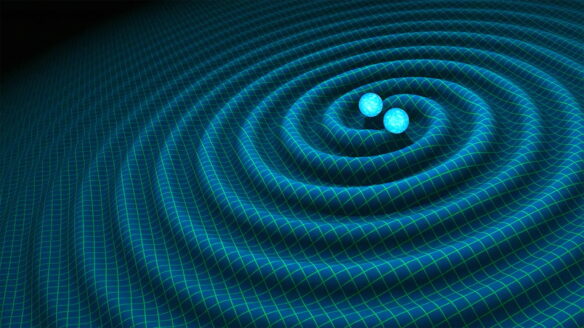By SF Concatenation’s Jonathan Cowie: This piece comes a couple of months ahead of appearing in next season’s SF2 Concatenation.
The pre-print of a rather dry, but fun – with a sprinkling of Star Trek references – “What no one has seen before: gravitational waveforms from warp drive collapse” — looks as to whether a warp drive would be detectable. The way to do it would be to use a gravity wave detector, and here a lot has happened the past decade or so.
Back in 2012 we inferred gravity waves by seeing the orbital decay a couple of tightly orbiting dwarf stars (JO651), some 3,000 light years away. Under Newtonian physics, this should not happen but under General Relativity such an orbiting system would generate gravity waves and so lose energy and the stars’ orbits about each other would decay. And this was what was observed.

Then in 2015 a laser inferometer (LIGO) first detected gravity waves. However, these types of detector can only detect gravity waves in a window limited mostly to frequencies in the range of around 100–1,000 hertz with a wave period of milliseconds. Now, there are other ways to detect gravity waves and in 2016 a new way was theorised using the change in frequency of pulsars (a gravity wave travelling through a pulsar would change the rate of its pulsing). It took just a decade to develop a detector but its first release of data in 2022 did not reveal any gravity waves. Fortunately, not long later (2023), a detection was made this way with wave lengths of many light years long and a frequency of hundredths of a microhertz. Such gravity waves are caused by orbiting supermassive black holes of the type commonly found in the centre of large galaxies.
That then is the background. So, what of the gravity waves generated by a theoretical warp drive? A small collaboration of European-based physicists (two in Great Britain and one in Germany) have just theorized what to look for. They hypothesized a one-kilometer diameter warp bubble (big enough for most self-respecting Federation starships) using an Alcubierre warp drive that was accelerating or decelerating (say due to warp containment failure) from a velocity of one-tenth the speed of light. Such a starship in our galaxy, or even as far away as Andromeda, would generate gravity waves with a frequency of around 300 kilohertz and a strain (equivalent to a movement) of 10-21. Now, the latter (the strain) would be (hypothetically) detectable by LIGO but, alas, the former (the frequency) would not.

So, that’s their theoretical calculation. So, could we in reality detect such waves any other way? The bad news is, sadly, not yet, as such waves are outside current methods of detecting gravity waves of this frequency. The good news is that there are theoretical/hypothetical ways of detecting such gravity waves using Bose-Einstein condensates (matter in either a very cold or highly compressed state).
Of course, the other problem is for a variety of reasons – not least the necessity of some exotic physics – in realising (with our current understanding) an Alcubierre warp drive as that entails physics that may perhaps confine such drives purely to the realm of science fiction. This exotic physics includes negative energy and mass, something of which we bioscientists are a tad wary, but which some physicists think they may have detected in 2017. So maybe there is hope? If only the energy needed was not so prohibitive: the energy of the gravity waves generated by such a starship would have 1/100 times the mass-energy of the Sun… No wonder Scotty was always a tad on edge when the engines went critical: though I always had a nagging suspicion that William Shatner never really understood this! Having said that, it would be interesting to see if there were such gravity waves, especially if there were loads of them as there would be with an interstellar, Star Trek type Federation at war with the Klingons or Borg as there would bound to be loads of collapsing warp bubbles, or if it were possible to safely rapidly switch off an Alcubierre warp at a journey’s end. If there were loads of such detections we would need some alternative explanations for them otherwise we might have to turn to the science fiction…
Fortunately, while the pre-print paper is rather dry, its abstract is understandable and its end a little fun…
Despite originating in science fiction, warp drives have a concrete description in general relativity, with Alcubierre first proposing a space-time metric that supported faster-than-light travel. Whilst there are numerous practical barriers to their implementation in real life, including a requirement for negative energy, computationally, one can simulate their evolution in time given an equation of state describing the matter. In this work, we study the signatures arising from a warp drive ‘containment failure’, assuming a stiff equation of state for the fluid. We compute the emitted gravitational-wave signal and track the energy fluxes of the fluid. Apart from its rather speculative application to the search for extraterrestrial life in gravitational wave detector data, this work is interesting as a study of the dynamical evolution and stability of space-times that violate the null energy condition. Our work highlights the importance of exploring strange new space-times, to (boldly) simulate what no one has seen before.
See Clough, K., Dietrich, T. & Khan, S. (2024) “What no one has seen before: gravitational waveforms from warp drive collapse”. Preprint at arXiv.
Discover more from File 770
Subscribe to get the latest posts sent to your email.

The authors… one is… Khan, S?